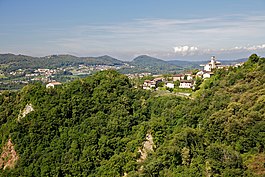Castel San Pietro, Switzerland
| Castel San Pietro | ||
|---|---|---|
 |
||
|
||
| Coordinates: 45°52′N 9°01′E / 45.867°N 9.017°ECoordinates: 45°52′N 9°01′E / 45.867°N 9.017°E | ||
| Country | Switzerland | |
| Canton | Ticino | |
| District | Mendrisio | |
| Government | ||
| • Mayor |
Sindaco Lorenzo Bassi |
|
| Area | ||
| • Total | 11.83 km2 (4.57 sq mi) | |
| Elevation | 442 m (1,450 ft) | |
| Population (Dec 2015) | ||
| • Total | 2,096 | |
| • Density | 180/km2 (460/sq mi) | |
| Postal code | 6874 | |
| SFOS number | 5249 | |
| Surrounded by | Balerna, Bruzella, Cabbio, Caneggio, Coldrerio, Melano, Mendrisio, Morbio Inferiore, Morbio Superiore, Muggio, Rovio, San Fedele Intelvi (IT-CO) | |
| Website |
castelsanpietro SFSO statistics |
|
Castel San Pietro is a municipality in the district of Mendrisio in the canton of Ticino in Switzerland.
Castel San Pietro is first mentioned in 1171 as Castellum Sancti Petri. A settlement near the village was mentioned in 865, when an Imperial knight named Sigeradus, granted the area to the monastery of Sant'Ambrogio in Milan. The municipality was originally part of the Vicinanza of Balerna. By 1270 it had an Imperial palace and it was given to Como Cathedral. During the war between Milan and Como (1118–27) a castle was built, which was the origin of the municipality's name. By the mid-13th Century it passed back and forth between the Bishop of Como and the Russ and Rusconi family. At the end of the 14th Century it finally fell into the hands of the family. In the 15th Century, it became part of the Pieve of Balerna., claims it made claims. Bishop Boniface built a church in the Castle in 1343. It was later named in memory of the bloody feud between the Bosia and Rusconi family in 1390, as the "Red Church".
Since 1626, Castel San Pietro, has been a separate parish. The parish church of S. Eusebio was mentioned in 1270, but the existing building dates from the 17th-18th Centuries and was restored in 1912.
In the Middle Ages and the early modern era the Catholic Church (Church of S. Fedele and the Bishop of Como) and powerful, local families (Albrici, Rusconi, and after the 15th century, the Turconi, as witnessed by their Villa Turconi a Loverciano) possessed lands in and around the village. The land was mostly farmed in sharecropping and was all tithed. These charges meant that the land could not always feed the entire population, so that some of the population were compelled to emigrate. At the beginning of the 20th Century a small industrial base (tobacco processing, distilleries) developed in the valley. In the 1960s and 1970s other companies (textiles, watches and metal processing) moved into the village.
...
Wikipedia




